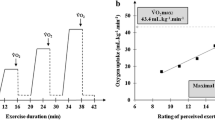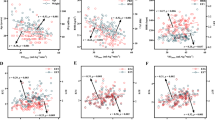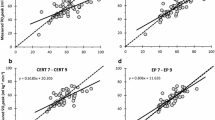Abstract
Maximal or peak oxygen uptake (\( {\dot{\text{V}}\text{O}}_{2} { \hbox{max} } \) and \( {\dot{\text{V}}\text{O}}_{2} {\text{peak}} \), respectively) are commonly measured during graded exercise tests (GXTs) to assess cardiorespiratory fitness (CRF), to prescribe exercise intensity and/or to evaluate the effects of training. However, direct measurement of CRF requires a GXT to volitional exhaustion, which may not always be well accepted by athletes or which should be avoided in some clinical populations. Consequently, numerous studies have proposed various sub-maximal exercise tests to predict \( {\dot{\text{V}}\text{O}}_{2} { \hbox{max} } \) or \( {\dot{\text{V}}\text{O}}_{2} {\text{peak}} \). Because of the strong link between ratings of perceived exertion (RPE) and oxygen uptake ( \( {\dot{\text{V}}\text{O}}_{2} \)), it has been proposed that the individual relationship between RPE and \( {\dot{\text{V}}\text{O}}_{2} \) (RPE:\( {\dot{\text{V}}\text{O}}_{2} \)) can be used to predict \( {\dot{\text{V}}\text{O}}_{2} { \hbox{max} } \) (or \( {\dot{\text{V}}\text{O}}_{2} {\text{peak}} \)) from data measured during submaximal exercise tests. To predict \( {\dot{\text{V}}\text{O}}_{2} { \hbox{max} } \) or \( {\dot{\text{V}}\text{O}}_{2} {\text{peak}} \) from these linear regressions, two procedures may be identified: an estimation procedure or a production procedure. The estimation procedure is a passive process in which the individual is typically asked to rate how hard an exercise bout feels according to the RPE scale during each stage of a submaximal GXT. The production procedure is an active process in which the individual is asked to self-regulate and maintain an exercise intensity corresponding to a prescribed RPE. This procedure is referred to as a perceptually regulated exercise test (PRET). Recently, prediction of \( {\dot{\text{V}}\text{O}}_{2} { \hbox{max} } \) or \( {\dot{\text{V}}\text{O}}_{2} {\text{peak}} \) from RPE:\( {\dot{\text{V}}\text{O}}_{2} \) measured during both GXT and PRET has received growing interest. A number of studies have tested the validity, reliability and sensitivity of predicted \( {\dot{\text{V}}\text{O}}_{2} { \hbox{max} } \) or \( {\dot{\text{V}}\text{O}}_{2} {\text{peak}} \) from RPE:\( {\dot{\text{V}}\text{O}}_{2} \) extrapolated to the theoretical \( {\dot{\text{V}}\text{O}}_{2} { \hbox{max} } \) at RPE20 (or RPE19). This review summarizes studies that have used this predictive method during submaximal estimation or production procedures in various populations (i.e. sedentary individuals, athletes and pathological populations). The accuracy of the methods is discussed according to the RPE:\( {\dot{\text{V}}\text{O}}_{2} \) range used to plot the linear regression (e.g. RPE9–13 versus RPE9–15 versus RPE9–17 during PRET), as well as the perceptual endpoint used for the extrapolation (i.e. RPE19 and RPE20). The \( {\dot{\text{V}}\text{O}}_{2} { \hbox{max} } \) or \( {\dot{\text{V}}\text{O}}_{2} {\text{peak}} \) predictions from RPE:\( {\dot{\text{V}}\text{O}}_{2} \) are also compared with heart rate-related predictive methods. This review suggests that \( {\dot{\text{V}}\text{O}}_{2} { \hbox{max} } \) (or \( {\dot{\text{V}}\text{O}}_{2} {\text{peak}} \)) may be predicted from RPE:\( {\dot{\text{V}}\text{O}}_{2} \) extrapolated to the theoretical \( {\dot{\text{V}}\text{O}}_{2} { \hbox{max} } \) (or \( {\dot{\text{V}}\text{O}}_{2} {\text{peak}} \)) at RPE20 (or RPE19). However, it is generally preferable to (1) extrapolate RPE:\( {\dot{\text{V}}\text{O}}_{2} \) to RPE19 (rather than RPE20); (2) use wider RPE ranges (e.g. RPE ≤ 17 or RPE9–17) in order to increase the accuracy of the predictions; and (3) use RPE ≤ 15 or RPE9–15 in order to reduce the risk of cardiovascular complications in clinical populations.


Similar content being viewed by others
References
Åstrand PO, Rodahl K, Dahl HA, Stromme SB. Textbook of work physiology: physiological bases of exercise. 4th ed. Champaign: Human Kinetics; 2003.
Howley ET, Bassett DR, Welch HG. Criteria for maximal oxygen uptake: review and commentary. Med Sci Sports Exerc. 1995;27(9):1292–301.
Wilmore JH, Costill DL. Metabolism, energy, and the basic energy systems. In: Wilmore JH, Costill DL, editors. Physiology of sport and exercise. 3rd ed. Champaign: Human Kinetics; 2004.
American College of Sports Medicine. General principles of exercise prescription. In: American College of Sports Medicine, editor. ACSM’s guidelines for exercise testing and prescription. 6th ed. Philadelphia: Lippincott Williams and Wilkins; 2000. p. 137–64.
Vandewalle H. Oxygen uptake and maximal oxygen uptake: interests and limits of their measurements. Ann Readapt Med Phys. 2004;47(6):243–57.
Paton CD, Hopkins WG. Tests of cycling performance. Sports Med. 2001;31(7):489–96.
Lamberts RP, Swart J, Woolrich RW, Noakes TD, Lambert MI. Measurement error associated with performance testing in well-trained cyclists: application to the precision of monitoring changes in training status. Int Sport Med J. 2009;10(1):33–44.
Coquart JB, Eston R, Nycz M, Grosbois J-M, Garcin M. Estimation of maximal oxygen uptake from ratings of perceived exertion elicited during sub-maximal tests in competitive cyclists. Arch Sci Med. 2012;171(2):165–72.
Sassi A, Marcora SM, Rampinini E, Mognoni P, Impellizzeri FM. Prediction of time to exhaustion from blood lactate response during submaximal exercise in competitive cyclists. Eur J Appl Physiol. 2006;97(2):174–80.
Noonan V, Dean E. Submaximal exercise testing: clinical application and interpretation. Phys Ther. 2000;80(8):782–807.
Åstrand PO, Ryhming I. A nomogram for calculation of aerobic capacity (physical fitness) from pulse rate during sub-maximal work. J Appl Physiol. 1954;7(2):218–21.
Borel B, Fabre C, Saison S, Bart F, Grosbois JM. An original field evaluation test for chronic obstructive pulmonary disease population: the six-minute stepper test. Clin Rehabil. 2010;24(1):82–93.
Lamberts RP, Swart J, Noakes TD, Lambert MI. A novel submaximal cycle test to monitor fatigue and predict cycling performance. Br J Sports Med. 2011;54:797–804.
Sartor F, Vernillo G, de Morree HM, Bonomi AG, La Torre A, Kubis HP, et al. Estimation of maximal oxygen uptake via submaximal exercise testing in sports, clinical, and home settings. Sports Med. 2013;43(9):865–73.
Billat V, Lopes P. Indirect methods for estimation of aerobic power. In: Maud PJ, Foster C, editors. Physiological assessment of human fitness. Champaign: Human Kinetics; 2006. p. 19–38.
Tanaka H, Monahan KD, Seals DR. Age-predicted maximal heart rate revisited. J Am Coll Cardiol. 2001;37(1):153–6.
Robergs RA, Landwehr R. The surprising history of the “HRmax = 220 − age” equation. JEP Online. 2002;5(2):1–10.
Galloway SD, Maughan RJ. Effects of ambient temperature on the capacity to perform prolonged cycle exercise in man. Med Sci Sports Exerc. 1997;29(9):1240–9.
Palatini P, Benetos A, Julius S. Impact of increased heart rate on clinical outcomes in hypertension: implications for antihypertensive drug therapy. Drugs. 2006;66(2):133–44.
Eston R, Connolly D. The use of ratings of perceived exertion for exercise prescription in patients receiving beta-blocker therapy. Sports Med. 1996;21(3):176–90.
Van Baak MA. Beta-adrenoceptor blockade and exercise: an update. Sports Med. 1988;5(4):209–25.
Faulkner J, Eston R. Perceived exertion research in the 21st century: developments, reflections and questions for the future. J Exerc Sci Fit. 2008;6(1):1–14.
Noble BJ, Robertson RJ. Perceived exertion. Champaign: Human Kinetics; 1996.
Eston R. Use of ratings of perceived exertion in sports. Int J Sports Physiol Perf. 2012;7(2):175–82.
Borg G. Perceived exertion as an indicator of somatic stress. Scand J Rehabil Med. 1970;2(2):92–8.
Borg G. Borg’s perceived exertion and pain scales. Champaign: Human Kinetics; 1998.
Borg G. The Borg RPE scale. In: Borg G, editor. Borg’s perceived exertion and pain scales. Champaign: Human Kinetics; 1998. p. 29–38.
Chen MJ, Fan X, Moe ST. Criterion-related validity of the Borg ratings of perceived exertion scale in healthy individuals: a meta-analysis. J Sports Sci. 2002;20(11):873–99.
Coquart JB, Legrand R, Robin S, Duhamel A, Matran R, Garcin M. Influence of successive bouts of fatiguing exercise on perceptual and physiological markers during an incremental exercise test. Psychophysiology. 2009;46(1):209–16.
Eston RG, Brodie DA. Responses to arm and leg ergometry. Br J Sports Med. 1986;20(1):4–6.
Eston RG, Davies BL, Williams JG. Use of perceived effort ratings to control exercise intensity in young healthy adults. Eur J Appl Physiol Occup Physiol. 1987;56(2):222–4.
Pfeiffer KA, Pivarnik JM, Womack CJ, Reeves MJ, Malina RM. Reliability and validity of the Borg and OMNI rating of perceived exertion scales in adolescent girls. Med Sci Sports Exerc. 2002;34(12):2057–61.
Ainsworth BE, McMurray RG, Veazey SK. Prediction of peak oxygen uptake from submaximal exercise tests in older men and women. J Aging Phys Activ. 1997;5:27–38.
Eston R, Faulkner J, Clair Gibson A, Noakes T, Parfitt G. The effect of antecedent fatiguing activity on the relationship between perceived exertion and physiological activity during a constant load exercise task. Psychophysiology. 2007;44(5):779–86.
Ceci R, Hassmen P. Self-monitored exercise at three different RPE intensities in treadmill vs field running. Med Sci Sports Exerc. 1991;23(6):732–8.
Dishman RK. Prescribing exercise intensity for healthy adults using perceived exertion. Med Sci Sports Exerc. 1994;26(9):1087–94.
Eston RG, Lamb KL, Parfitt G, King N. The validity of predicting maximal oxygen uptake from a perceptually-regulated graded exercise test. Eur J Appl Physiol. 2005;94(3):221–7.
Eston RG, Thompson M. Use of ratings of perceived exertion for predicting maximal work rate and prescribing exercise intensity in patients taking atenolol. Br J Sports Med. 1997;31(2):114–9.
Eston RG, Faulkner JA, Mason EA, Parfitt G. The validity of predicting maximal oxygen uptake from perceptually regulated graded exercise tests of different durations. Eur J Appl Physiol. 2006;97(5):535–41.
Al-Rahamneh HQ, Eston RG. Prediction of peak oxygen consumption from the ratings of perceived exertion during a graded exercise test and ramp exercise test in able-bodied participants and paraplegic persons. Arch Phys Med Rehabil. 2011;92(2):277–83.
Al-Rahamneh HQ, Faulkner JA, Byrne C, Eston RG. Prediction of peak oxygen uptake from ratings of perceived exertion during arm exercise in able-bodied and persons with poliomyelitis. Spinal Cord. 2011;49(1):131–5.
Coquart JB, Garcin M, Grosbois J-M, Wibaux F, Dubart A-E, Lemaire C. Estimation de la consommation pic d’oxygène par la perception de l’effort chez des patients obèses et diabétiques de type 2. Obésité. 2011;6(1):98–104.
Coquart JB, Lemaire C, Dubart AE, Douillard C, Luttenbacher DP, Wibaux F, et al. Prediction of peak oxygen uptake from sub-maximal ratings of perceived exertion elicited during a graded exercise test in obese women. Psychophysiology. 2009;46(6):1150–3.
Faulkner J, Eston R. Overall and peripheral ratings of perceived exertion during a graded exercise test to volitional exhaustion in individuals of high and low fitness. Eur J Appl Physiol. 2007;101(5):613–20.
Lambrick DM, Faulkner JA, Rowlands AV, Eston RG. Prediction of maximal oxygen uptake from submaximal ratings of perceived exertion and heart rate during a continuous exercise test: the efficacy of RPE 13. Eur J Appl Physiol. 2009;107(1):1–9.
Jones AM, Vanhatalo AT, Doust JH. Aerobic exercise performance. In: Eston RG, Reilly T, editors. Kinanthropometry and exercise physiology laboratory manual: tests, procedures and data. London: Routledge; 2009. p. 237–70.
St Clair Gibson A, Lambert MI, Hawley JA, Broomhead SA, Noakes TD. Measurement of maximal oxygen uptake from two different laboratory protocols in runners and squash players. Med Sci Sports Exerc. 1999;31(8):1226–9.
Bolgar MR, Baker CE, Goss FL, Nagle E, Robertson RJ. Effect of exercise intensity on differentiated and undifferentiated ratings of perceived exertion during cycle and treadmill exercise in recreationally active and trained women. J Sports Sci Med. 2010;9:557–63.
Green JM, Crews TR, Bosak AM, Peveler WW. Overall and differentiated ratings of perceived exertion at the respiratory compensation threshold: effects of gender and mode. Eur J Appl Physiol. 2003;89(5):445–50.
Fitchett MA. Predictability of VO2max from submaximal cycle ergometer and bench stepping tests. Br J Sports Med. 1985;19(2):85–8.
Golding LA. Fitness testing and assessment manual. 4th ed. Champaign: Human Kinetics; 2000.
Coquart JB, Tourny-Chollet C, Lemaitre F, Lemaire C, Grosbois JM, Garcin M. Relevance of the measure of perceived exertion for the rehabilitation of obese patients. Ann Phys Rehabil Med. 2012;55(9–10):623–40.
Noble BJ, Robertson RJ. The role of RPE in graded exercise testing. In: Noble BJ, Robertson RJ, editors. Perceived exertion. Champaign: Human Kinetics; 1996. p. 215–55.
Gellish RL, Goslin BR, Olson RE, McDonald A, Russi GD, Moudgil VK. Longitudinal modeling of the relationship between age and maximal heart rate. Med Sci Sports Exerc. 2007;39(5):822–9.
Faulkner JA, Lambrick D, Parfitt G, Rowlands AV, Eston RG. Prediction of maximal oxygen uptake from the Åstrand–Ryhming nomogram and ratings of perceived exertion. In: Atkinson G, Reilly T, editors. Contemporary sport, leisure and ergonomics. London: Routledge; 2009. p. 197–214.
Zwiren LD, Freedson PS, Ward A, Wilke S, Rippe JM. Estimation of VO2max: a comparative analysis of five exercise tests. Res Q Exerc Sport. 1991;62(1):73–8.
Currell K, Jeukendrup AE. Validity, reliability and sensitivity of measures of sporting performance. Sports Med. 2008;38(4):297–316.
Ramsbottom R, Brewer J, Williams C. A progressive shuttle run test to estimate maximal oxygen uptake. Br J Sports Med. 1988;22(4):141–4.
Davies RC, Rowlands AV, Eston RG. The prediction of maximal oxygen uptake from submaximal ratings of perceived exertion elicited during the multistage fitness test. Br J Sports Med. 2008;42(12):1006–10.
Brewer J, Ramsbottom R, Williams C. Multistage fitness test: a progressive shuttle-run test for the prediction of maximum oxygen uptake. Leeds: National Coaching Foundation; 1988.
Balke B, Ware RW. An experimental study of physical fitness of Air Force personnel. U S Armed Forces Med J. 1959;10(6):675–88.
Smith EL, Gilligan C. Physical activity prescription for the older adult. Phys Sports Med. 1983;11:91–101.
Amundsen LR, DeVahl JM, Ellingham CT. Evaluation of a group exercise program for elderly women. Phys Ther. 1989;69(6):475–83.
Hampson DB, St Clair Gibson A, Lambert MI, Noakes TD. The influence of sensory cues on the perception of exertion during exercise and central regulation of exercise performance. Sports Med. 2001;31(13):935–52.
Williams JG, Eston RG. Determination of the intensity dimension in vigorous exercise programmes with particular reference to the use of the rating of perceived exertion. Sports Med. 1989;8(3):177–89.
Dunbar CC, Robertson RJ, Baun R, Blandin MF, Metz K, Burdett R, et al. The validity of regulating exercise intensity by ratings of perceived exertion. Med Sci Sports Exerc. 1992;24(1):94–9.
Parfitt G, Evans H, Eston R. Perceptually regulated training at RPE13 is pleasant and improves physical health. Med Sci Sports Exerc. 2012;44(8):1613–8.
Buckley JP, Eston RG, Sim J. Ratings of perceived exertion in Braille: validity and reliability in production mode. Br J Sports Med. 2000;34(4):297–302.
Eston RG, Williams JG. Reliability of ratings of perceived effort regulation of exercise intensity. Br J Sports Med. 1988;22(4):153–5.
Parfitt G, Eston R, Connolly D. Psychological affect at different ratings of perceived exertion in high- and low-active women: a study using a production protocol. Percept Mot Skills. 1996;82(3 Pt 1):1035–42.
Goosey-Tolfrey V, Lenton J, Goddard J, Oldfield V, Tolfrey K, Eston R. Regulating intensity using perceived exertion in spinal cord-injured participants. Med Sci Sports Exerc. 2010;42(3):608–13.
Paulson TA, Bishop NC, Eston RG, Goosey-Tolfrey VL. Differentiated perceived exertion and self-regulated wheelchair exercise. Arch Phys Med Rehabil. 2013;94(11):2269–76.
Paulson TA, Bishop NC, Leicht CA, Goosey-Tolfrey VL. Perceived exertion as a tool to self-regulate exercise in individuals with tetraplegia. Eur J Appl Physiol. 2013;113(1):201–9.
Kang J, Chaloupka EC, Mastrangelo MA, Donnelly MS, Martz WP, Robertson RJ. Regulating exercise intensity using ratings of perceived exertion during arm and leg ergometry. Eur J Appl Physiol Occup Physiol. 1998;78(3):241–6.
Marriott HE, Lamb KL. The use of ratings of perceived exertion for regulating exercise levels in rowing ergometry. Eur J Appl Physiol Occup Physiol. 1996;72(3):267–71.
Morris M, Lamb K, Cotterrell D, Buckley J. Predicting maximal oxygen uptake via a perceptually regulated exercise test (PRET). J Exerc Sci Fit. 2009;7(2):122–8.
Deci EL, Ryan RM. Intrinsic motivation and self-determination in human behavior. New York: Plenum Press; 1985.
Parfitt G, Eston R. Changes in ratings of perceived exertion and psychological affect in the early stages of exercise. Percept Mot Skills. 1995;80(1):259–66.
Eston R, Lambrick D, Sheppard K, Parfitt G. Prediction of maximal oxygen uptake in sedentary males from a perceptually regulated, sub-maximal graded exercise test. J Sports Sci. 2008;26(2):131–9.
Faulkner J, Parfitt G, Eston R. Prediction of maximal oxygen uptake from the ratings of perceived exertion and heart rate during a perceptually-regulated sub-maximal exercise test in active and sedentary participants. Eur J Appl Physiol. 2007;101(3):397–407.
Morris M, Lamb KL, Hayton J, Cotterrell D, Buckley J. The validity and reliability of predicting maximal oxygen uptake from a treadmill-based sub-maximal perceptually regulated exercise test. Eur J Appl Physiol. 2010;109(5):983–8.
Eston R, Evans H, Faulkner J, Lambrick D, Al-Rahamneh H, Parfitt G. A perceptually regulated, graded exercise test predicts peak oxygen uptake during treadmill exercise in active and sedentary participants. Eur J Appl Physiol. 2012;112(10):3459–68.
Evans HJ, Parfitt G, Eston RG. The perceptually regulated exercise test is sensitive to increases in maximal oxygen uptake. Eur J Appl Physiol. 2012;113(5):1233–9.
Al-Rahamneh HQ, Eston RG. The validity of predicting peak oxygen uptake from a perceptually guided graded exercise test during arm exercise in paraplegic individuals. Spinal Cord. 2011;49(3):430–4.
Groslambert A, Mahon AD. Perceived exertion: influence of age and cognitive development. Sports Med. 2006;36(11):911–28.
Eston RG, Lambrick DM, Rowlands AV. The perceptual response to exercise of progressively increasing intensity in children aged 7–8 years: validation of a pictorial curvilinear ratings of perceived exertion scale. Psychophysiology. 2009;46(4):843–51.
Groslambert A, Hintzy F, Hoffman MD, Dugue B, Rouillon JD. Validation of a rating scale of perceived exertion in young children. Int J Sports Med. 2001;22(2):116–9.
Robertson RJ, Goss FL, Boer NF, Peoples JA, Foreman AJ, Dabayebeh IM, et al. Children’s OMNI scale of perceived exertion: mixed gender and race validation. Med Sci Sports Exerc. 2000;32(2):452–8.
Williams JG, Eston R, Furlong B. CERT: a perceived exertion scale for young children. Percept Mot Skills. 1994;79(3 Pt 2):1451–8.
Egger M, Smith GD. Bias in location and selection of studies. BMJ. 1998;316:61–6.
Acknowledgments
No sources of funding were used in the preparation of this review. The authors have no potential conflicts of interest that are directly relevant to the content of the study. No other authors contributed to the writing of the manuscript.
Author information
Authors and Affiliations
Corresponding author
Rights and permissions
About this article
Cite this article
Coquart, J.B., Garcin, M., Parfitt, G. et al. Prediction of Maximal or Peak Oxygen Uptake from Ratings of Perceived Exertion. Sports Med 44, 563–578 (2014). https://doi.org/10.1007/s40279-013-0139-5
Published:
Issue Date:
DOI: https://doi.org/10.1007/s40279-013-0139-5




